Research Article Open Access
Evaluation of Elite Rice Varieties Unmasks New Sources of Bacterial Blight and Leaf Streak Resistance for Africa
| Issa Wonni1-3*, Mathilde Hutin1, Léonard Ouédrago2, Irénée Somda3, Valérie Verdier1 and Boris Szurek1 | |
| 1Institut de Recherche pour le Développement, UMR Interactions Plantes Micro-organismes Environnement, IRD-CIRAD-UM2, 911 Avenue Agropolis BP 64501, 34394 Montpellier Cedex 5, France | |
| 2Institut de l’Environnement et de Recherches Agricoles (INERA), Laboratoire Mixte International, observatoire des agents phytopathogènes en Afrique de l’Ouest (LMI Patho-Bios), 01 BP 910 Bobo Dioulasso, Burkina Faso | |
| 3Université Polytechnique de Bobo Dioulasso (UPB), 01 BP 1091 Bobo Dioulasso, Burkina Faso | |
| *Corresponding Author : | Issa Wonni Institut de Recherche pour le Développement UMR Interactions Plantes Micro-organismes Environnement IRD-CIRAD-UM2, France Tel: +22650347112 E-mail: wonniissa@yahoo.fr |
| Received: November 26, 2015 Accepted: January 12, 2016 Published: January 17, 2016 | |
| Citation: Wonni I, Hutin M, Ouédrago L, Somda I, Verdier V, et al. (2016) Evaluation of Elite Rice Varieties Unmasks New Sources of Bacterial Blight and Leaf Streak Resistance for Africa. J Rice Res 4:162. doi:10.4172/2375-4338.1000162 | |
| Copyright: © 2016 Wonni I, et al. This is an open-access article distributed under the terms of the Creative Commons Attribution License, which permits unrestricted use, distribution, and reproduction in any medium, provided the original author and source are credited. | |
Visit for more related articles at Rice Research: Open Access
Abstract
Background: Bacterial Leaf Blight (BLB) and Bacterial Leaf Streak (BLS) diseases respectively caused by Xanthomonas oryzae pv oryzae (Xoo) and X. oryzae pv oryzicola (Xoc) have become a real threat to rice production in West Africa. Genetic and pathogenicity studies revealed African X. oryzae (Xo) pathovars to be both fairly distant from their Asian counterparts. It is therefore mandatory to evaluate whether available major resistance genes are adapted for an efficient and durable control of BLB in Africa. As to BLS no resistance sources have been identified in rice so far. Results: We screened eleven upland and lowland elite rice varieties cultivated in Burkina Faso for resistance to bacterial blight and bacterial leaf streak. We show that all five upland varieties including three NERICAs are highly resistant to each of the three races of Xoo identified in Africa and generally susceptible to several strains from Asia. We next demonstrated that resistance is occurring independently of the plant developmental stage. Strikingly, phenotyping and in planta growth curves assays showed that the five varieties are also highly resistant to a set of Xoc strains representative of the diversity in West Africa. Finally, we show that resistance of the NERICA varieties to both Xoo and Xoc is likely to be inherited from the O. sativa ssp. japonica rather than the O. glaberrima parental lines. Conclusion: We identified and characterized rice accessions exhibiting new sources of resistance against African Xoo and Xoc strains specifically. These results provide important perspectives for the control of BLB and BLS in West Africa.
| Keywords |
| Disease resistance; Bacterial blight; Bacterial leaf streak; Upland varieties; NERICA rice cultivars |
| Background |
| The cultivation of rice has drastically increased in Africa over the last decade. Bacterial Blight (BLB) and Bacterial Leaf Streak (BLS) respectively caused by Xanthomonas oryzae pv oryzae (Xoo) and Xanthomonas oryzae pv oryzicola (Xoc), impose significant disease pressure on cultivated rice (Oryza sativa L), most particularly in irrigated and upland rice growing regions. While BLB was first reported in the 1980s in several West African rice growing countries. BLS is definitely considered a new emerging disease in West as well as in East Africa and Madagascar. Both diseases are expanding to new rice production areas and are therefore potential sources of serious threaten for food security in West Africa. BLB and BLS can cause severe yield losses of up to respectively 70% and 20% in rice irrigated areas, depending on the rice variety, host growth stage during epidemics, geographic location and seasonal conditions. In Burkina Faso, the intensification and expansion of rice areas with X. oryzae susceptible lines, may lead to an increase of BLB and BLS incidence in the country. For instance, BLB epidemics were reported in 1998 in Bagre area, leading to severe yield losses in fields planted with the Chinese rice variety TCS10. Moreover, in 2003 and more recently in 2009 to 2014, extensive surveys in Burkina Faso, Mali and Niger indicated a higher incidence of BLB and BLS diseases [1-9]. |
| During infection, Xoo enters the leaf through hydathodes or wounds and spreads systemically by multiplying in the xylem vessels. In contrast, Xoc which is a mesophyll colonizer, enters through leaf stomata or by injury. Both pathovars rely on a set of diverse molecular tools to overcome the host defense system and establish a favorable niche, thus resulting in BLB and BLS diseases. Xoo is able to infect adult plants and seedlings, respectively leading to leaf blight and wilting of young plants, a syndrome referred to as kresek. Kresek usually occurs during transplantation of seedlings from nurseries to the field, mainly because of leaf cuttings which occur prior transplantation and serve as major routes of infection. Employing cultivars with efficient resistance occurring at all developmental stages is therefore crucial and the most economical way to control the disease. Nowadays, at least 41 BLB resistance genes have been identified, of which eight have been isolated. The effectiveness of resistance at different developmental stages has been previously tested for many of these genes [10-17]. |
| African Xoo strains are genetically distant from Asian one and are notably characterized by a reduced set of transcription activatorlike (TAL) effector genes in their genome [2,9,6]. Moreover, three new races of the pathogen where identified among strains collected in West Africa. Race A1 is present in Niger, Burkina Faso and Cameroon, and is a virulent on near-isogenic lines (NILs) carrying Xa4, xa5 and Xa7. In contrast to Xoo, no races have been reported for Xoc, though quantitative differences in virulence of strains exist [18,19]. Despite some effort, no major genes for resistance to BLS have been identified in Oryza sativa so far. The only available source of genetic resistance is the Rxo1 R gene which was cloned from maize and transferred to rice, conferring resistance to Xoc strains carrying the effector gene xopAJ [20-22]. Yet, while xopAJ is highly conserved in Xoc strains from Asia, it is absent from the majority of African strains [2,14]. Deployment of Rxo1 gene-containing varieties is therefore not an appropriate breeding strategy for controlling BLS disease in Africa. More recently, [23] reported on the identification of the recessive gene bls1 from the wild species Oryza rufipogon but its spectrum of action is unknown. |
| In West Africa many improved varieties have been developed including NEw RICe for Africa (NERICA), which were developed with the aim of combining the high yields from Asian rice species Oryza sativa with the ability of the African species O. glaberrima (CG14) to resist local stresses. O. glaberrima is resistant to a number of major african diseases and pest such as blast, Rice yellow mottle virus, sheath blight, nematodes, stem borer and African gall midge [24-28]. Yet, [29] recently evaluated a subset of 107 O. glaberrima accessions for resistance to BLB and reported that only a few of them were resistant to African Xoo strains. Despite of the importance of the areas cultivated with improved varieties and NERICA lines in Africa, little is known about their interaction with X. oryzae. Understanding the resistance level of these accessions towards the diversity of African Xoo and Xoc strains and the influence of plant developmental on their function is essential for optimal disease control. With the objective of evaluating the resistance status of most popular rice elite varieties cultivated in Burkina Faso against African X. oryzae pathovars, our study unraveled unexpected sources of resistance in rice that are mostly effective against a wide range of Xoo and Xoc strains from Africa (Figure S1 and Table 1). |
| Results |
| Evaluation of rice elite varieties cultivated in Burkina Faso for resistance to African Xanthomonas oryzae pv. oryzae |
| In an attempt to examine the potential of rice elite varieties cultivated in Burkina Faso to control BLB disease, we performed leaf-clip inoculation of the eleven most popular varieties. As detailed in Table 1, four O. sativa improved rice varieties and seven NERICA cultivars were inoculated with Xoo strains BAI3, BAI4 and MAI1 representing the three races identified so far in Africa and the Asian Xoo reference strain PXO99A. To our surprise, a high level of resistance against the three African races could be evidenced in five varieties, including three NERICA cultivars (NERICA 12, NERICA 13 and NERICA 17) and two improved rice varieties (FKR19 and FKR43). Remarkably, all these accessions are adapted to upland ecosystems Table 2. Conversely, lowland varieties (FKR14, FKR28, NERICA-L-20 and NERICA-L-19) were susceptible to all strains, except for NERICA-L-41 and NERICA-L-60, which resisted against races A2 and A3 but not race A1. Noteworthy, upland resistant accessions derived from an O. sativa ssp japonica background or, in the case of NERICAs, from interspecific crosses involving O. sativa ssp japonica as recurrent parent. Reciprocally, varieties made from intra- or interspecific crosses deriving from O. sativa ssp. indica parents were generally susceptible (Figure 1A and Table 3). Finally, a strong HR-like response was observed five days-post infiltration of leaves of each of the five upland resistant varieties with each of the three African Xoo strains, as exemplified for NERICA 12 cultivar when challenged with strain BAI3 (Tables 2 and 3) (Figure 1 and Figure S2). |
| Upland Burkinabe rice varieties exhibit resistance against African but not Asian strains of X. oryzae pv. oryzae |
| To confirm the resistance phenotypes of upland varieties, we next performed in planta growth curves analysis of each of the three African Xoo races and strain PXO99A in the five resistance accessions. As illustrated in Figure 2, quantification of bacterial populations within the top 10 cm at 4, 8 and 12 days after leaf-clip inoculation clearly confirmed the capacity of the resistant varieties to prevent the growth of the three African strains. In line with the observation that African Xoo strains elicited an HR-like response in resistant plants, growth of these strains were significantly reduced starting 4 days after inoculation. In contrast, inoculation of each of the five resistant accessions with Asian Xoo strain PXO99A led to full bacterial growth, as expected from the pathogenicity assays. Thus, we next addressed the question whether additional Xoo strains representative of the Asian population diversity would also be virulent on Burkinabe rice resistant varieties. We selected five strains originating from five different geographic locations in Asia, therefore corresponding to five genetic lineages. Interestingly, each of the five Asian Xoo strains were virulent on upland Burkinabe rice accessions with the exception of NERICA 17. Interestingly the O. glaberrima donor parent accession CG14 turned out to control four out of six of the tested Xoo strains. Altogether these results suggest that the identified sources of resistance within Burkinabe upland elite rice varieties preferentially act against African Xoo races (Figure 2 and Figure S2). |
| The BLB resistance phenotype of upland varieties is not influenced by plant development |
| Understanding the range of developmental phases in which a given resistance is effective is particularly important for the deployment of the variety carrying this resistance. To that end, we evaluated the effect of different growth stages on the resistance level of several Burkinabe rice varieties. We compared them to IRBLB lines containing either Xa4, xa5 or Xa7, for which a similar study had been conducted previously [17]. As shown in Figure 3, the Xoo strain BAI3 which is virulent on the susceptible lines IR24 and FKR14, accordingly produced disease symptoms at all growth stages. In contrast, leaf-clip inoculation of the five resistant upland varieties with BAI3, but also Xoo strains BAI4 and MAI1, led to the appearance of a typical dark brown phenotype suggesting of an HR response (not shown). This resistance response was evidenced at all developmental stages, from seedlings to adult plants, and in all tested upland varieties. In conclusion, these results indicate that the resistance mechanisms unmasked in Burkinabe upland rice is not affected by plant development. Moreover, while not a single lesion could be detected on upland varieties upon inoculation of African Xoo strains, they still were able to maintain some levels of virulence on IRBLB lines, with the exception of MAI1 which is anyway avirulent on IR24 (Figure 3). |
| Burkinabe upland varieties confer resistance against bacterial leaf streak |
| We next investigated the potential of Burkinabe upland rice varieties to control BLS. Nine African Xoc strains representative of at least three pathotypes and of different geographic origins Table 2 [9] were leaf-infiltrated on our set of eleven Burkinabe elite rice varieties and scored for disease development 8 days-post infiltration. To our surprise, eight out of 12 tested varieties were able to confer resistance against BLS Table 3, including the four improved rice varieties FKR14, FKR19, FKR28 and FKR43, the three upland varieties NERICA 12, NERICA 13 and NERICA 17, as well as one lowland NERICA variety (NERICA-L-19). A follow-up of symptoms appearance dynamic over a 12-days period was next operated on six resistant varieties, including the five upland accessions that were resistant to BLB. Plants were inoculated with Xoc strains BAI6, BAI11 and BLS256 and lesions were scored at 4, 8 and 12 days post inoculation. Strikingly, no disease symptoms could be observed over the time course on any of the Burkinabe elite varieties inoculated with African Xoc strains BAI6 and BAI11 (Figures 4A and 4B). In contrast, the Asian Xoc strain BLS256 was able to produce variable disease symptoms on the six resistant varieties (Figure 4C). To confirm these results, we performed in planta bacterial growth curves based on the same experimental setup as for pathogenicity assays. While Xoc strains BAI6 and BAI11 were able to grow on control susceptible line Kitaake, no bacterial multiplication could be evidenced in Burkinabe varieties (Figures 5A and 5B). As expected, the observed growth phenotype was reminiscent of what we observed upon inoculation of the rice accession Kitaake-Rxo1, which is resistant to Xoc strains carrying the avirulence gene xopAJ, such as BAI6 or BLS256 but not BAI11. In conclusion, among eleven rice elite varieties cultivated in Burkina, we showed that eight of them are able to confer resistance to bacterial leaf streak (Figures 4 and 5). |
| The O. sativa ssp. japonica parental lines of upland NERICA varieties confer resistance to African strains of Xoo and Xoc |
| NERICA varieties result from interspecific crosses between O. glaberrima and O. sativa ssp japonica or indica accessions, with the aim of combining specific agro-ecological adaptation of local varieties to the high yielding potential of O. sativa subspecies. O. glaberrima germplasm, domesticated in West Africa, possesses useful genetic traits, such as good levels of resilience against abiotic and biotic stresses but generally has a low yield potential and unfavourable agronomic characteristics. Upland NERICA cultivars were developed from crosses between the O. glaberrima cultivar CG14 as donor and japonica subspecies [25]. NERICA 12/13 and NERICA 17 respectively derive from crosses with the recurrent lines WAB56-50 and WAB181-18. Thus, we evaluated the resistance level exhibited by these two recurrent japonica subsp. parental lines and the O. glaberrima donor. Leaf-infiltration of African but not Asian Xoo strains led to a resistance and disease symptoms in respectively both O. sativa ssp. japonica recurrent and O. glaberrima donor parental lines, similarly to what was observed upon infiltarion of NERICA 17. In the same line of idea, inoculation of the African Xoc strain BAI6 respectively conducted to a resistance phenoptype and BLS symptoms on japonica ssp and O. glaberrima accessions. Altogether, our results show that the resistance phenotype uncovered in the three upland NERICA varieties were probably inherited from the japonica subspecies genomes. |
| Materials and Methods |
| Plant material and Xanthomonas oryzae strains |
| Seeds of rice cultivars and near isogenic lines were obtained from Agricultural and Environmental Research Institute (INERA-Burkina Faso), IRD-Montpellier and Africa-Rice-Benin. Upland NERICAs were developed from the crosses between O. sativa ssp japonica WAB56-50 or WAB181-18, and the O. glaberrima CG14 accession. Irrigated-lowland NERICAs were developed from the crosses between the O. sativa ssp. indica IR64 accession and the O. glaberrima TOG5681 accession. Kitaake and Kitaake transgenic line containing the Rxo1 gene were used as control to characterize resistance phenotypes against Xoc. Plants were grown under controlled conditions (28°C, 80% humidity and 12-h day length) in the greenhouse at IRD Montpellier. X. oryzae strains used in this study are described in Table 2. X. oryzae cells were cultivated at 28°C in PSA medium (10 g of peptone, 10 g of sucrose, 1 g of glutamic acid, 16 g of agar per liter of H2O) as already described [2]. |
| Pathogenicity assays |
| For the evaluation of resistance, plants were inoculated at 21 days after sowing by leaf-clipping inoculation, as described previously [30]. Prior inoculation, strains were streaked on PSA medium and the inoculum was prepared by resuspending bacterial cells in sterile distilled water at an optical density of 0.2 (λ = 600 nm), bearing approximately 108 CFU/ml. Ten leaves of ten different individuals were inoculated per variety. At 14 days after inoculation (dai), we assessed leaf lesion length (in cm). For leaf infiltration assays, X. oryzae strains were introduced with a needleless syringe into the intercellular spaces of rice leaves from 3-weeks-old plants at concentrations of 108 cfu ml-1 as described previously [31]. The HR was scored at 72-96h after inoculation. All these experiments were conducted three times independently. |
| Assessment of bacterial numbers |
| Ability of bacterium to multiply in the plant tissues was assessed at 4, 8 and 12 days after inoculation of three weeks old plants. For Xoo the number of bacterial cells in the leaves was determined within the top 10cm of each leaf. Xoc cells number was assessed from the portion of leaf where symptoms developed, including the site of inoculation and around. Leaf sections were surface-sterilized in 75% ethanol for 10 s, followed by submersion in sterile water for 30 s, and crushed and resuspended in 1ml sterile distilled water. Leaf homogenates were serially diluted (up to 10-12) and plated onto PSA medium amended with cephalexin (40 ug/ml), kasugamicyn (20 ug/ml) and cycloheximide (50 ug/ml) to avoid contamination. The plates were incubated at 28°C until single colonies could be counted. The experiment was repeated independently three times. |
| Discussion |
| Upon the phenotypic evaluation of eleven elite rice varieties from Burkina Faso for resistance against X. oryzae pv oryzae and X. oryzae pv oryzicola, we demonstrated that five of them hold the full potential to controling both BLB and BLS diseases in sub-Saharan Africa. Noteworthy, all five resistant accessions were equally efficient towards a range of African Xoo and Xoc strains representative of the race and pathotype diversity in the region, respectively. In contrast, typical BLB symptoms developed when plants were challenged with a set of five Xoo strains originating from diverse areas in Asia and corresponding to different lineages. In the same line of idea, inoculation of the plants with the Asian Xoc strain BLS256 also led to typical BLS symptoms. This is suggesting that the unveiled resistance is targeting African strains of Xoo and also potentially Xoc, specifically. Finally, in all accessions, the resistance response was visualized as an early browning at the inoculation site, which is reminiscent of an HR-like phenotype. To our knowledge, this is the first report on the characterization of rice varieties exhibiting resistance against both pathovars of Xanthomonas oryzae. Given no resistance sources against BLS was ever reported in rice so far, these results are of major interest towards the development of potential novel genetic mechanisms. |
| From an applied point of view, the evaluation of the resistance level towards biotic stresses executed by popular elite varieties is crucial as it enables to predict epidemics, provided data on pathogen populations structure are available. While NERICA varieties and other improved varieties developed by national and international programs are nowadays used wide-spread in Burkina Faso and other countries in Africa, a picture as to their ability to control or not local strains of Xoo and Xoc was crucially missing until this study. As a matter of fact, one major output of our work will be to assist regional and national programs responsible for the selection of rice varieties to be cultivated in Burkina on a yearly base. In tight conjunction with annual monitoring of local pathogen populations diversity, our results should concretely help to reduce the incidence of BLB and BLS diseases, by guiding the ce of appropriate rice genotypes in Burkina and surrounding countries. |
| Altogether, our results enabled to identify a potentially new source of resistance against BLB in several upland rice varieties including two improved rice varieties (FKR19 and FKR43) and three NERICA varieties (NERICA 12, NERICA 13 and NERICA 17). Strikingly the associated resistance phenotype is typically characterized by an HRlike response at the site of inoculation appearing within 3-4 days post-infection, and conducing to the absolute arrest of bacterial growth observed as early as 4 days post infiltration. This feature differs from what was reported previously for the xa5 resistance gene, which controls disease by restricting bacterial movement down the leaf, but still allows bacterial multiplication to high levels at the site of inoculation [32]. Surprisingly, despite of different genetic backgrounds, the five upland varieties, all displayed a similar resistance spectrum which was always associated with the very same typical HRlike macroscopic response. While, it is impossible to infer from our data whether the genetic basis underlying this phenotype is the same among all the lines, examination of their pedigree indicate that they all inherited from at least one O. sativa ssp. japonica accession (Table 3). This is suggesting that at least some genetic determinants required for resistance might be deriving from O. sativa ssp japonica. In addition for NERICA varieties, our analysis of the donor (O. glaberrima CG14) and recurrent parental lines (japonica WAB56-50 and WAB181-18) indicates that the resistance phenotype observed in their progenies is probably inherited from the japonica subspecies genomes. Indeed, both of the two japonica recurrent parents exhibited the typical HRlike response. Because the genome sequence of many NERICA varieties including NERICA 12, NERICA 13 and NERICA 17, is being processed (Sabot F and Ghesquière A), and since the one of the donor parental line CG14 is already available [32], our prospect of isolating the genetic regions and candidate genes underlying the resistance against African X. oryzae strains might become a reality in a much sooner time period than expected (Figure 6). |
| Many of the isolated crop R genes reported so far confer resistance to a narrow spectrum of races relying on gene-for-gene types of interactions. Our results show that while upland varieties are susceptible to Asian Xoo, they are highly resistant to African Xoo and Xoc strains. This strongly suggests that African X. oryzae strains are targeted preferentially as a potential result of some rice plants adaptation to local aggressive strains. Noteworthy, African X. oryzae strains are genetically distant from those from Asia and are characterized by a comparatively reduced number of transcription activator-like (TAL) effector genes [2]. Interestingly, a mutation in hrcC which disrupts the functionality of the type three secretion system of Xoo strain BAI3, prevented induction of the typical HR-like response on the NERICA 12 variety (data not shown). This is suggesting that the elicitor of this response could be a type three effector. As in the Rice/Xoo pathosystem, the only examples reported so far of effectors holding avr activity are TAL effectors, we hypothesize that they might be good Avr candidates for the elicitation of HR on upland varieties. Future experiments requiring the isolation of the full TAL effectors repertoire of African Xoo strains might help to identify the potential elicitor triggering the resistance response we unraveled in African upland varieties [33,34]. |
| In conclusion host-plant resistance is a cost effective and environmentally safe approach to reduce yield loss caused by pathogenic bacteria. Our study showed that all tested African Xoo and Xoc strains are avirulent on upland cultivars from Burkina Faso. Based on the effectiveness of these accessions to resist to the African Xo at all stages of growth under greenhouse conditions, it is next imperious to assess this potential in field conditions. In a near future, our major prospect will be the elucidation of the molecular genetic basis of the resistance mechanisms we identified and characterized in African upland rice varieties, as such achievement is a prerequisite for the development of new locally-adapted and pathogen-informed cultivars with multiple and durable resistance suitable for use in farmers fields. |
| Competing Interest |
| The authors declare that they have no competing interest. |
| Author’s Contribution |
| IW and MH carried out the experiments and data analysis. LO, IS and VV provided scientific comments. IW and BS designed the study design, and wrote the manuscript. All authors read and approved the final manuscript. |
| Acknowledgement |
| Wonni was supported by a PhD fellowship from IRD (ARTS). This work was partially supported by INERA (Burkina Faso), and grants from the International Foundation for Science (IFS) awarded to I Wonni (C/4813-1 and C/4813-2) and from GRiSP (MENERGEP NewFrontier program). We wish to thank A. Ghesquière for providing us with NERICA seed material and parental lines. |
References |
|
Tables and Figures at a glance
| Table 1 | Table 2 | Table 3 |
Figures at a glance
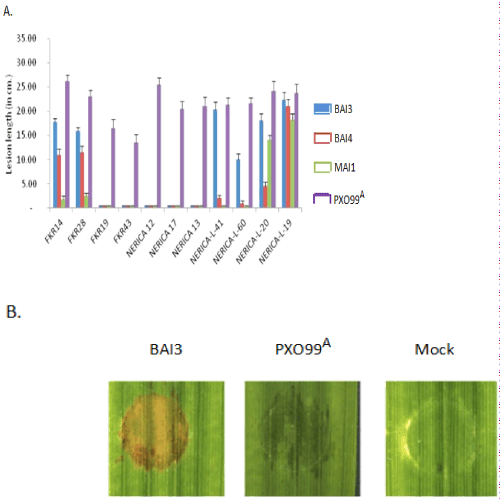 |
 |
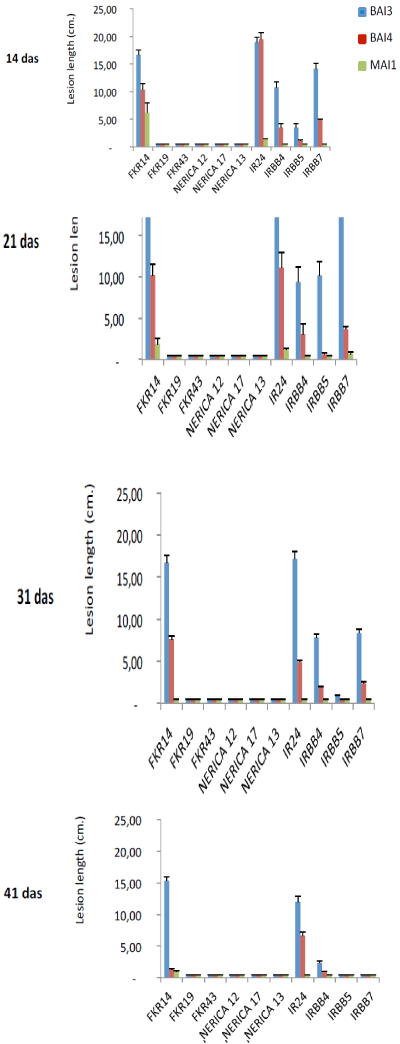 |
| Figure 1 | Figure 2 | Figure 3 |
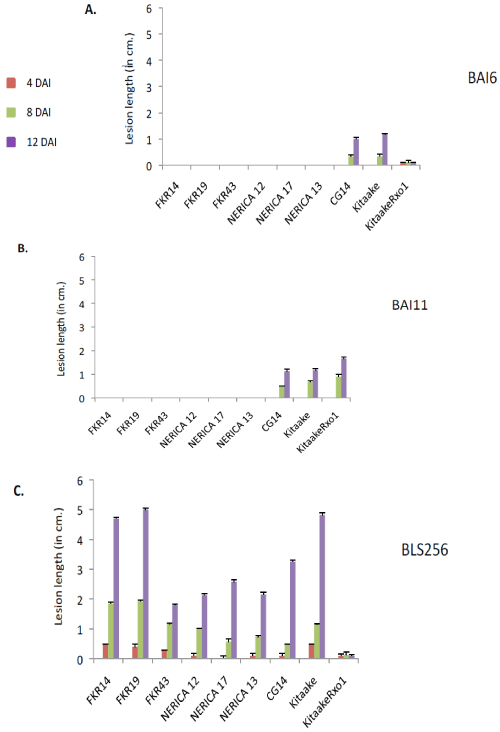 |
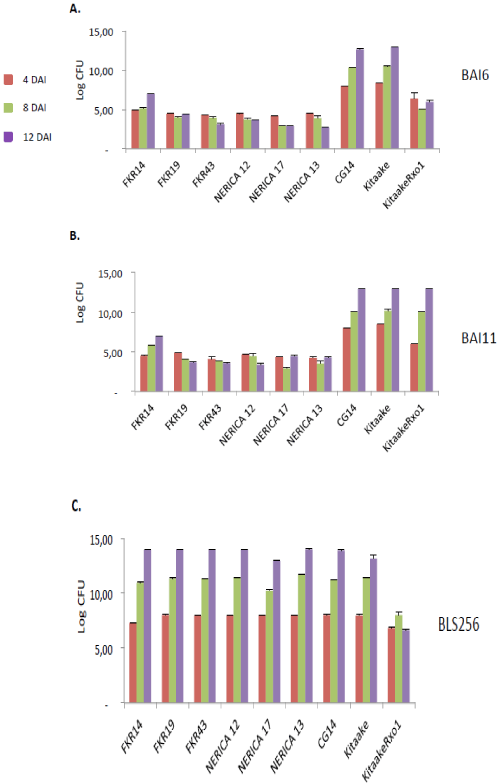 |
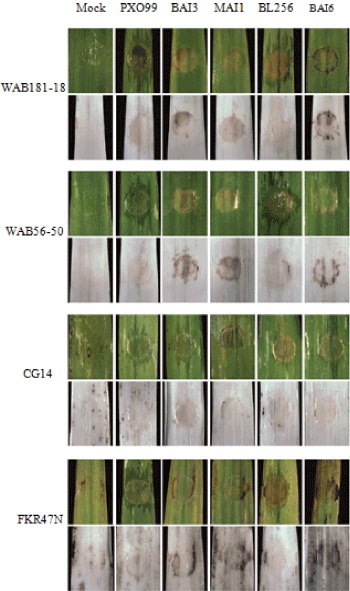 |
| Figure 4 | Figure 5 | Figure 6 |
Relevant Topics
- Basmati Rice
- Drought Tolerence
- Golden Rice
- Leaf Diseases
- Long Grain Rice
- Par Boiled Rice
- Raw Rice
- Rice
- Rice and Aquaculture
- Rice and Nutrition
- Rice Blast
- Rice Bran
- Rice Diseases
- Rice Economics
- Rice Genome
- Rice husk
- Rice production
- Rice research
- Rice Yield
- Sticky Rice
- Stress Resistant Rice
- Unpolished Rice
- White Rice
Recommended Journals
Article Tools
Article Usage
- Total views: 12893
- [From(publication date):
February-2016 - Jul 11, 2025] - Breakdown by view type
- HTML page views : 11789
- PDF downloads : 1104
